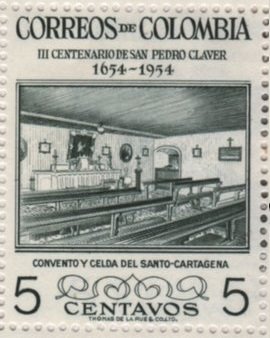Stamp: Convent and cell of St. Peter Claver (Colombia 1955)
Convent and cell of St. Peter Claver (Colombia 1955)
02 May (Colombia ) within release Death of St. Peter Claver, 300th Anniv. goes into circulation Stamp Convent and cell of St. Peter Claver face value 5 Colombian centavo
| Stamp Convent and cell of St. Peter Claver in catalogues | |
|---|---|
| Michel: | Mi: CO 697 |
| Leo Temprano: | Lt: CO HF6a |
Stamp is vertical format.
Stamp from souvenir sheet BL6. Similar to SN 627, but printed in diferent color. Printed by Thomas De La Rue & Co. Ltd. Peter Claver was a Spanish-born Jesuit priest who dedicated his life to helping the African slaves, giving them a sense of their own personal dignity. He became the patron saint of slaves, seafarers, the Republic of Colombia and ministry to AfricansAlso in the issue Death of St. Peter Claver, 300th Anniv.:
- Stamp - Convent and cell of St. Peter Claver face value 15;
- Souvenir Sheet - Convent and cell of St. Peter Claver face value 15;
- Stamp - Convent and cell of St. Peter Claver face value 5;
Stamp Convent and cell of St. Peter Claver it reflects the thematic directions:
A church building, often simply called a church, is a building used for Christian religious activities, particularly worship services. The term in its architectural sense is most often used by Christians to refer to their religious buildings, but it is sometimes used (by analogy) for buildings of other religions. In traditional Christian architecture, the church is often arranged in the shape of a Christian cross. When viewed from plan view the longest part of a cross is represented by the aisle and the junction of the cross is located at the altar area. Towers or domes are often added with the intention of directing the eye of the viewer towards the heavens and inspiring church visitors. Modern church buildings have a variety of architectural styles and layouts; many buildings that were designed for other purposes have now been converted for church use; and, similarly, many original church buildings have been put to other uses. The earliest identified Christian church was a house church founded between 233 and 256. During the 11th through 14th centuries, a wave of building of cathedrals and smaller parish churches occurred across Western Europe. A cathedral is a church, usually Roman Catholic, Anglican, Oriental Orthodox or Eastern Orthodox, housing the seat of a bishop.

